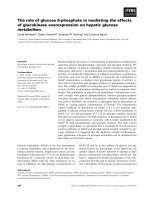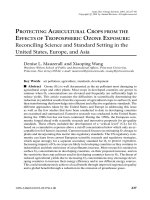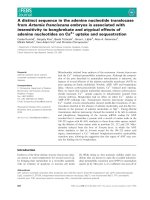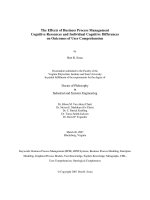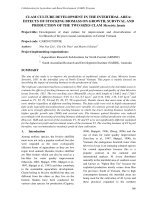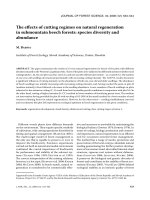The effects of timber logging on stand structure and species composition in north zamayi reserver forest, tharyarwddy district, myanma
Bạn đang xem bản rút gọn của tài liệu. Xem và tải ngay bản đầy đủ của tài liệu tại đây (5.19 MB, 129 trang )
MINISTRY OF EDUCATION AND
TRAINING
MINISTRY OF AGRICULTURE AND
RURAL DEVELOPMENT
VIETNAM NATIONAL UNIVERSITY OF FORESTRY
--------------------
MYO MIN THANT
THE EFFECTS OF TIMBER LOGGING ON STAND
STRUCTURE AND SPECIES COMPOSITION IN NORTH
ZAMAYI RESERVE FOREST, THARYARWADDY
DISTRICT, MYANMAR
MASTER THESIS IN FOREST SCIENCE
Hanoi, 2018
MINISTRY OF EDUCATION AND
MINISTRY OF AGRICULTURE AND RURAL
TRAINING
DEVELOPMENT
VIETNAM NATIONAL UNIVERSITY OF FORESTRY
--------------------
MYO MIN THANT
THE EFFECTS OF TIMBER LOGGING ON STAND
STRUCTURE AND SPECIES COMPOSITION IN NORTH
ZAMAYI RESERVE FOREST, THARYARWADDY
DISTRICT, MYANMAR
Major: Forest Science
Code: 8620201
MASTER THESIS IN FOREST SCIENCE
Signature: ………………………….
Supervisor: Dr. MANH HUNG BUI
Hanoi, 2018
Abstract
Natural forests in Myanmar are being managed based on sustainable forest
management principle; under a regulation of Myanmar Selection System (MSS) since
1856. Notwithstanding the hundreds years of its reputation of good forest management and
timbers that stand firmly as the essence of gross national proceeds, concerns over the longstanding practice of MSS is widely debated in term of sustainability when after the
production forests were adversely threatened by degradation. Although the mixed
deciduous forests in Myanmar are renowned as legendary of teak bearing forests, the
impact of selective logging, which has conducted annually over centuries, remains
unknown. Therefore, it needs the hands of the people, especially foresters and researchers.
Through research, scientists can provide the knowledge and understanding of the forest,
including the structure and forest restoration.
This study was conducted at NZRF, Tharyarwaddy, Myanmar to evaluate the
change of floristic characteristics, structure and regeneration potential of teak bearing
forest in Bago region after selective logging in order to contribute the scientific findings to
improve the silvicultural system applied to sustainable forest management in this region.
The evaluation based on data collected from one hectare of each forest types; forests after
10 years and 20 years of selective logging, in representative for two harvested sites in
comparison with new data collected from one hectare of old-growth forest nearby as a
control. This study has obtained important findings. Results show that, selective logging
forests have been changed in all floristic characteristics, structure and regeneration
potential in comparison with primary forest and between two harvested sites. In floristic
characteristics, this change is clear in species richness, species composition and species
similarity. The secondary forest is more homogeneous and uniform, while the old-growth
forest is very diverse. While in stand structure, the change is clear vertical and horizontal
structure, diameter distribution, stand density, basal area, stock volume and volume
increment. Biodiversity of the overstorey in the secondary forest is more than the primary.
Density of regeneration is also shown a different between old-growth forest and
harvested forest, between harvested forest sites. The secondary forest still has mother trees
and sufficient regeneration, so some restoration measures can be applied here. Findings of
the study contribute to improve people’s understanding of the structure and the structural
i
changes after harvesting in NZRF. That is a key to have better understandings of the
history and values of the forests. These findings and the proposed restoration measures
address rescuing degraded forests in Bago region in particular and Myanmar in general.
And further, this is a promising basis for the management and sustainable use of forest
resources in the future.
Keywords: NZRF, Myanmar Selection System, reserve forest, natural regeneration,
stand structure, species diversity, sustainable forest management.
ii
CONTENTS
Abstract ……………...………………………………………………………………i
List of Figure ...…………….……….………………………………………………vi
List of Table ………………...………………………………….…………………viii
Abbreviation ………………………………………………………………………...x
CHAPTER I. Introduction ..........................................................................................1
1.1. Background Information ................................................................................... 1
1.2. The state of Forest in Myanmar......................................................................... 3
1.3. Myanmar Selection System ............................................................................... 5
1.4. Problem Statement ............................................................................................. 8
1.5. Objectives and research questions of the study ................................................. 9
1.5.1. General Objectives ......................................................................................... 9
1.5.2. Specific Objectives ......................................................................................... 9
CHAPTER II. Literature Review ..............................................................................10
2.1. Tropical forest in the world ............................................................................. 10
2.2. Deforestation ................................................................................................... 12
2.2.1. Major causes of deforestation ...................................................................... 13
2.3. Tropical mixed deciduous forest in Myanmar................................................. 14
2.4. Deforestation and forest degradation in Myanmar .......................................... 16
2.5. Review of AAC for timber harvesting in Myanmar ........................................ 18
2.6. Sustainable tropical forest management .......................................................... 19
2.7. Silvicultrual management system of tropical forests ...................................... 20
2.8. Stand structure, species dynamic and natural regeneration in natural forest .. 22
iii
CHAPTER III. Materials ..........................................................................................24
3.1. General description of study site ..................................................................... 24
3.1.1. Topography .................................................................................................. 25
3.1.2. Climate ......................................................................................................... 26
3.1.3. History of silvicultural and forest management practices in the study site.. 28
CHAPTER IV. Methodology ....................................................................................29
4.1. Establishment of permanent sample plots/ sampling design ........................... 29
4.2. Data collection method .................................................................................... 31
4.2.1. Tree data collection ...................................................................................... 31
4.2.2. Coordinate of the tree ................................................................................... 32
4.2.3. Data collection for regeneration ................................................................... 33
4.3. Data analysis method ....................................................................................... 34
4.3.1. Stand Information ......................................................................................... 34
4.3.2. Descriptive statistics for height and diameter variables ............................... 35
4.3.3. Linear mixed-effects analysis ....................................................................... 38
4.3.4. Frequency distributions ................................................................................ 38
4.3.5. Diameter-height regression analysis ............................................................ 40
4.3.6. Spatial point patterns of tree species ............................................................ 41
4.3.7. Tree species composition analysis results .................................................... 41
4.3.8. Regeneration storey structure analysis ......................................................... 44
CHAPTER V. Results and Discussion .....................................................................45
5.1. Stand information ............................................................................................ 45
5.2. Descriptive statistics results ............................................................................ 48
5.2.1. Vertical and horizontal projections .............................................................. 51
5.3. Linear mixed effect model results ................................................................... 53
5.4. Frequency distributions ................................................................................... 55
5.5. Diameter-height regression results .................................................................. 63
5.6. Spatial distribution analysis ............................................................................. 66
iv
5.6.1. Density testing results .................................................................................. 66
5.6.2. Spatial distribution pattern testing ................................................................ 70
5.7. Tree species composition analysis results ....................................................... 74
5.7.1. Family composition ...................................................................................... 74
5.7.2. Species composition ..................................................................................... 77
5.7.3. Species similarity ......................................................................................... 79
5.7.4. Species Diversity .......................................................................................... 81
5.8. Regeneration storey structure analysis results ................................................. 82
5.8.1. Height frequency distribution ....................................................................... 82
5.8.2. Biodiversity index for regeneration .............................................................. 87
5.9. Silvicultural approaches for SFM in the North Zamayi RF ............................ 90
CHAPTER VI. Conclusion .......................................................................................93
ACKNOWLEDGEMENT ........................................................................................96
REFERRENCES .......................................................................................................97
APPENDIX ………………………………………………………………………105
v
LISTS OF FIGURE
FIGURE 2.1: FOREST COVERS AT DIFFERENT PERIODS IN MYANMAR ............. 16
FIGURE 2.2: TREND OF CHANGES IN ‘OPEN FOREST’ TO ‘CLOSED FOREST’ IN
MYANMAR ................................................................................................................. 17
FIGURE 2.3: CHANGE OF AAC FOR TEAK (TECTONA GRANDIS) OVER 1995 TO
2011 AT COUNTRY LEVEL ...................................................................................... 18
FIGURE 2.4: CHANGE OF AAC FOR HARDWOOD SPECIES OVER 1995 TO 2011
AT COUNTRY LEVEL ............................................................................................... 18
FIGURE 2.5: NATIONAL INCOME FROM TIMBER EXPORT DURING 2000 TO 2012
...................................................................................................................................... 19
FIGURE 3.1: LOCATION OF NORTH ZAMAYI RESERVE FOREST .......................... 25
FIGURE 3.2: CLIMATE DIAGRAM OF NORTH ZAMAYI RESERVE NEAR
THARYARWADDY TOWNSHIP; DATA RECORDED FROM 2008 TO 2017
(METROLOGICAL DEPARTMENT, THARYARWADDY TOWNSHIP) .............. 28
FIGURE 4.1: THREE DIFFERENT KINDS OF FOREST IN NZRF ................................ 29
FIGURE 4.2: SAMPLE PLOT ............................................................................................ 30
FIGURE 4.3: MEASURING POSITION OF DBH ............................................................ 31
FIGURE 4.4: DIAMETER MEASUREMENT BY USING A DIAMETER TAPE .......... 32
FIGURE 4.5: HEIGHT MEASUREMENT BY USING A BLUE-LEISS ......................... 32
FIGURE 4.6: SUB-PLOTS FOR MEASURING TREE POSITION .................................. 33
FIGURE 4.7: REGENERATING TREE INVESTIGATION ............................................. 33
FIGURE 5.1: VERTICAL AND HORIZONTAL PROJECTIONS FOR ALL FOREST
TYPES .......................................................................................................................... 51
FIGURE 5.2: DIAMETER FREQUENCY DISTRIBUTION GRAPHS FOR OLD
GROWTH FOREST ..................................................................................................... 56
FIGURE 5.3: DIAMETER FREQUENCY DISTRIBUTION GRAPHS FOR 20 YEARS
AFTER LOGGING FOREST ...................................................................................... 57
FIGURE 5.4: DIAMETER FREQUENCY DISTRIBUTION GRAPHS FOR 10 YEARS
AFTER LOGGING FOREST ...................................................................................... 58
vi
FIGURE 5.5: HEIGHT FREQUENCY DISTRIBUTION GRAPHS FOR OLD GROWTH
FOREST ....................................................................................................................... 60
FIGURE 5.6: HEIGHT FREQUENCY DISTRIBUTION GRAPHS FOR 20 YEARS
AFTER LOGGING FOREST ...................................................................................... 61
FIGURE 5.7: HEIGHT FREQUENCY DISTRIBUTION GRAPHS FOR 10 YEARS
AFTER LOGGING FOREST ...................................................................................... 62
FIGURE 5.8: THE HEIGHT AND DBH RELATIONSHIP OF ALL STEMS WITH A
DBH≥ 6 CM OF OLD GROWTH FOREST IN NZRF ............................................... 64
FIGURE 5.9: THE HEIGHT AND DBH RELATIONSHIP OF ALL STEMS WITH A
DBH ≥ 6 CM OF FOREST (AFTER 20 YEAR LOGGING) IN NZRF ..................... 64
FIGURE 5.10: THE HEIGHT AND DBH RELATIONSHIP OF ALL STEMS WITH A
DBH≥ 6 CM OF DEGRADED FOREST (AFTER 10 YEAR LOGGING) IN NZRF 65
FIGURE 5.11: TREE POSITION ON THE GROUND OF OLD GROWTH .................... 67
FIGURE 5.12: TREE POSITION ON THE GROUND AFTER 20 YEARS OF LOGGING
...................................................................................................................................... 68
FIGURE 5.13: TREE POSITION ON THE GROUND AFTER 10 YEARS OF LOGGING
...................................................................................................................................... 69
FIGURE 5.14: DENSITY DISTRIBUTION ....................................................................... 70
FIGURE 5.15: THE PAIR CORRELATION FUNCTION RESULTS OF OLD-GROWTH
...................................................................................................................................... 71
FIGURE 5.16: THE PAIR CORRELATION FUNCTION RESULTS OF 20 YEARS
AFTER HARVESTING ............................................................................................... 72
FIGURE 5.17: THE PAIR CORRELATION FUNCTION RESULTS OF 10 YEARS
AFTER HARVESTING ............................................................................................... 73
FIGURE 5.18: REGENERATION HEIGHT FREQUENCY DISTRIBUTION FOR OLD
GROWTH FOREST ..................................................................................................... 83
FIGURE 5.19: REGENERATION HEIGHT FREQUENCY DISTRIBUTION FOR 20
YEARS AFTER LOGGING FOREST ........................................................................ 84
FIGURE 5.20: REGENERATION HEIGHT FREQUENCY DISTRIBUTION FOR 10
YEARS AFTER LOGGING FOREST ........................................................................ 85
FIGURE 5.21: REGENERATION SPECIES ACCUMULATION CURVES ................... 88
vii
LISTS OF TABLE
TABLE 1.1: STATUS OF PERMANENT FOREST ESTATE ............................................ 5
TABLE 3.1: MONTHLY MEAN RAINFALL AND TEMPERATURE (2008-2017) AND
DE MARTONNE’S ARIDITY INDEX FOR THARYARWADDY TOWNSHIP,
2018. ............................................................................................................................. 27
TABLE 4.1: MEASURE OF DISPERSION AND VARIABILITY ................................... 36
TABLE 4.2: EQUATIONS USED FOR REGRESSION .................................................... 40
TABLE5.1: STAND INFORMATION FOR PLOTS ......................................................... 46
TABLE 5.2: DESCRIPTIVE STATISTICS FOR DIAMETER VARIABLE .................... 49
TABLE 5.3: DESCRIPTIVE STATISTICS FOR HEIGHT VARIABLE .......................... 52
TABLE 5.4: LINEAR MIXED EFFECT MODEL FOR DBH ........................................... 53
TABLE 5.5: LINEAR MIXED EFFECT MODEL FOR H ................................................ 54
TABLE 5.6: MOST IMPORTANT FAMILIES OF THE OLD GROWTH FOREST OF
NZRF (ALL STEMS WITH A DBH ≥ 6CM). ............................................................ 75
TABLE 5.7: MOST IMPORTANT FAMILIES OF THE 20 YEARS AFTER LOGGING
FOREST OF NZRF (ALL STEMS WITH A DBH ≥ 6CM). ...................................... 75
TABLE 5.8: MOST IMPORTANT FAMILIES OF THE 10 YEARS AFTER LOGGING
FOREST OF NZRF (ALL STEMS WITH A DBH ≥ 6CM). ...................................... 76
TABLE 5.9: MOST IMPORTANT SPECIES OF THE OLD GROWTH FOREST OF
NZRF (ALL STEMS WITH A DBH ≥ 6CM). ............................................................ 77
TABLE 5.10: MOST IMPORTANT SPECIES OF THE 20 YEARS AFTER LOGGING
FOREST OF NZRF (ALL STEMS WITH A DBH ≥ 6CM). ...................................... 78
TABLE 5.11: MOST IMPORTANT SPECIES OF THE 10 YEARS AFTER LOGGING
FOREST OF NZRF (ALL STEMS WITH A DBH ≥ 6CM). ...................................... 78
TABLE 5.12: THE SIMILARITY COEFFICIENT (KD) AMONG THE DIFFERENT
FOREST TYPES (ALL STEMS WITH A DBH ≥ 6CM) IN NZRF. .......................... 80
TABLE 5.13: DIVERSITY INDICES (SIMPSON, SHANNON-WEINER, AND
EVENNESS) OF THREE DIFFERENT FOREST TYPES OF NZRF (ALL STEMS
WITH A DBH ≥ 6CM). ................................................................................................ 81
viii
TABLE 5.14: SPECIES DIVERSITY FOR REGENERATION OF OLD GROWTH
FOREST ....................................................................................................................... 87
TABLE 5.15: SPECIES DIVERSITY FOR REGENERATION OF 20 YEARS AFTER
LOGGING FOREST .................................................................................................... 87
TABLE 5.16: SPECIES DIVERSITY FOR REGENERATION OF 10 YEARS AFTER
LOGGING FOREST .................................................................................................... 88
ix
ABBREVIATION
AAC = Annual Allowable Cut
FAO = Food and Agriculture Organization of United Nations
FD = Forest Department
Ha = hectare
km2 = Square kilometer
cm = centimeter
MTE = Myanmar Timber Enterprise
MUMD = Moist Upper Mixed Deciduous Forest
WC
= Plantation Working Circle
RF = Reserve Forest
RIL = Reduced Impact Logging
x
CHAPTER I. INTRODUCTION
1.1.
Background Information
Forest, as defined by FAO, is a land spanning more than 0.5 hectares with
trees higher than 5 meters and a canopy cover of more than 10 percent, or trees able
to reach these thresholds in situ. Forests, which cover about 4 billion hectares and,
about 31 percent of the earth’s land surface are one of the most invaluable and
important renewable natural resources that can be found on earth[1, 2]. Especially,
tropical forests representing about 42% of the total forest area are the largest in area
and of important source of biodiversity and carbon sink of the world and they play
multiple roles in sustainable development and environmental protection [3]. The
functions of tropical forests can be productive (timber, fiber, fuelwood, and nontimber forest products), environmental (climate regulation, carbon sequestration and
storage, reserve of biodiversity, and soil and water conservation), and social
(subsistence for local population and cultures) [4, 5]. Despite their importance,
tropical forests are among the most threatened ecosystem on the earth. Tropical
deforestation is one of the primary causes of global environmental change [6].
Deforestation of tropical forest was about 13 million hectare annually during a
period of 2000 to 2010 [7]. Especially, deforestation and forest degradation of the
tropics have been occurring at an unprecedented rate and scale in Southeast Asia [8,
9]; they are continuing problems for many countries in southeastern Asia [1].
In the context of tropical forest, total wood production was estimated at 190
million m3 annually [3]. Tropical wood extraction in several forms is cited as one of
the main proximate causes of deforestation [10]. There has been considerable
debate about timber harvesting in tropical forests and its impacts on environmental,
cultural and social value [11]. Globally, two billion people are reported to rely on
biomass fuel for cooking. Wood energy accounts for up to 80% of energy consume
in some developing countries [12]. The global annual utilization of wood is
estimated to be about one thousand million ton [8]. Commercial wood extraction is
1
frequent in both mainland and insular in Asia whereas harvesting of fuelwood and
poles by individuals for domestics uses dominates cases of deforestation associated
with wood extraction. Traditionally, timber industry has been one of the main
income generating resources used in developing a country economy[13]. For
International Tropical Timber Organization (ITTO) member countries including
Myanmar, timber production is one of the main pillars of income to communities,
government and resource to industry.
Selective logging in commercial timber harvesting from tropical natural
forest has been playing an important role to meet wood demand nationally and
internationally. They are, however, identified as one of the main causes of
deforestation and forest degradation, especially in tropical rainforest such as
Amazon [14] and Indonesia. According to ITTO estimation, at least 350 million ha
of tropical forests have been severely damaged, and a further 500 million ha have
been degraded due mainly to unsustainable logging [3]. In tropical Myanmar, the
principal forest management known as Myanmar Selection System (MSS) has been
practiced since 1856 [15]. Under this system, teak and a few commercially
important hardwoods species are selectively harvested by 30 years felling cycle,
prescribed exploitable size and within the bound of annual allowable cut. Log
skidding is done mainly by elephant to cause little ecological damage. Due to the
hundreds years of its experiences of continuous timber extractions, MSS is
considered as sustainable and suitable for maintaining the multi-species, complex
natural teak bearing forests of tropical Myanmar though there is still little scientific
evidence on it. Particularly, the extent of an effect of logging under MSS and its
contribution in the context of deforestation and forest degradation remains
unknown. Recent studies has shown that current harvesting level by means of
logging frequency under MSS was strongly significant in causing forest degradation
but not in deforestation [8] and logging road has greater effect on canopy changes
than teak stumps [16]. In this study the focus is to evaluate logging and its effects
2
on stand structure and composition as implication in relation to deforestation and
forest degradation.
1.2.
The state of Forest in Myanmar
Myanmar, a tropical country in Continental Southeast Asia is situated within
latitude 9° 32´ N to 28° 31´ N and longitudes 92 degrees 10´ E to 101 degrees 11´
East [17]. Approximately 75% of its total area of 676,577 square km lies within the
tropic [18]. . Apart from its wide latitudinal range Myanmar also has an altitudinal
range from sea level in the southern coast to snow-capped mountain towering with
the highest elevation around 6,000 meter in the northern tip near the Chinese border.
As a consequence, it has a wide range of temperatures as high as about 43◦C in the
central region from below 0°C in the northwest and northern part. The annual
rainfall which is distributed over five months of the year ranges from more than
5000 mm in the coastal region to less than 1000 mm in its central part. All these
contribute towards a wide variety of environmental condition and diversity in the
types of forests that exist within the country.
Myanmar is still endowed with natural forests that cover about half of the
country’s territory, stretching over an area of 31.8 million ha [17]. Because of its
richness in biodiversity and natural resources, Myanmar is one of the countries in
the mainland Southeast Asia where the richest forest resources are found [1, 7].
According to RFA, 2015, Myanmar has one of the highest proportions of forest
cover in mainland South East Asia, 42.92% of the total land area is covered by
forests [7]. According to Kermode (1964), there are eight major forest types;
tropical evergreen forest, hill and temperate evergreen forest, mixed deciduous
forest, dry forest, deciduous dipterocarp forest, tidal forest or mangrove forest,
beach and dune forest, swamp forest[19]. They are a prime source both for
production of valuable wood and non-wood forest products and provide
indispensable protective services. The most important forest types are: mixed
deciduous forests including teak (38% of the total forest area); hill and mountain
3
evergreen forests (26%); tropical evergreen forests (16%); dry forests (10%);
deciduous dipterocarp forests (5%); and tidal swamp forests (4%) [18].
These varied forest types of Myanmar are home of nearly 300 known
mammal species, 360 reptiles, about 1000 avifauna species, about 1000 butterfly
species and over 10000 of plant species (FD 2003) [20]. Myanmar, therefore,
represents an important biodiversity reservoir in Asia[21].
Forest land is owned by the State and but it is legally classified as reserved
forests, protected areas and public protected or unclassified forests. So far 13
million ha of the forest area (37.8 % of the total) have been corresponded to
Permanent Forest Estate (PFE), of which 3.3 million ha are designated as
conservation reserves (i.e., protected areas) and the remaining 9.7 million ha are
defined as production forests (i.e., forest reserves) [22]. Forest reserve means an
area for designating forests and other natural areas, which enjoy judicial and/ or
constitutional protection under the legal systems. They also play a crucial role in
fulfilling the basic needs of the local people and maintaining their heritage and also
in the environmental stabilization.
From management sector, all natural forests in Myanmar are under the
management of the State and have been categorized legally as reserved forests and
public forests or unclassified forests. A total forest area which is 19million hectares
(30.72% of the country’s area) is categorized as permanent forest estate (PFE).
4
Table 1.1: Status of Permanent Forest Estate
Present of land
Category
Area (ha)
area
Reserved Forest
12184291
18
4094960
6.05
Protected Area System 3510685
6.67
Total
30.72
Protected
Public
Forest
19789936
Source: [23]
Within the PEF, 9.7 million hectares are designated as production forests
comprising 8.3 million of mixed deciduous and 1.4 million ha of evergreen
forests[24]. The natural forests, in which timbers harvesting are being conducted at
the present days, have been managed by forest management system known as
Myanmar Selection System.
1.3.
Myanmar Selection System
The Myanmar Selection System (MSS), formerly known as the Burma
Selection System is principally an exploitation-cum-cultural system with the main
features being to carefully protect the immature stock and assist it to attain maturity.
Myanmar forests have been sustainably managed under the Myanmar Selection
System since 1856[15, 25].
MSS involves adoption of a felling cycle of 30 years, prescription of
exploitable sizes of trees, girdling of teak, selection marking of other non-teak
hardwoods, felling of less valuable trees interfering with the growth of teak,
thinning of congested teak stands, enumeration of future yield trees down to fixed
sizes and fixing of annual allowable cuts (AACs) for teak and other hardwoods.
5
For the management purpose, the forests are classified into different
Working Cycles. Classification is based on the accessibility, the nature and form of
the forest products availability. The Working Cycles consist of a group of Reserved
Forests, which are further divided into Felling Series according to the drainage
pattern and geographical condition. Felling Series are sub-divided into Annual
Coupes which consist of a basic unit known as Compartment or a group of
Compartments. As felling cycle under MSS is 30-year, a Felling Series is divided
into 30 blocks of approximately equal yield capacity. Each year, selective logging is
carried out in one of these blocks and the whole forest is, therefore, worked over the
felling cycle of 30 years. When felling becomes due, all marketable trees, which
have attained a fixed exploitable girth limit, are selected for cutting. For teak, the
girth varies with the type and status of the forests. For all teak forests, the girth limit
at breast height (1.3m) 63cm DBH [25]. The fixed girth limit for other hardwoods
varies with the species, but mostly 58-78cm. Unhealthy trees that have not attained
these exploitable sizes, but are marketable, are also selected for cutting if they are
unlikely to survive during the subsequent felling cycle. If seed-bearers are scarce, a
few high-quality stems of and above the exploitable size may be retained as seed
trees.
The forest management system have devised to bring conservative
silviculture into harmony with profitable exploitation on a sustainable basis. In this
perspective, the Modified Myanmar Selection System (MMSS) integrates
modifications on[26, 27]:
- Length of felling cycle: The MSS employs a 30-year felling cycle
irrespective of site and forest types. The MMSS will apply site-specific felling
cycles. The felling cycle must allow the accumulation of growth at least sufficient
for efficient and economically profitable extraction. The longer the felling cycle the
more profitable is the extraction; but it must not be too long to prevent the trees
from becoming over mature and wasted.
6
- Unit of yield regulation: Under the MSS, yield (of both teak and other
hardwoods) is regulated by felling series, which is to be completely covered during
the felling cycle of 30 years. Neither residual growing stock nor stand structure is
identified. To enable regulation of growing stock and stand structure to achieve
desirable levels, the size of the felling series is too big. Thus, under the MMSS yield
will be fixed by compartment, which has a total area of about 300 to 400 ha. Each
compartment will be subdivided according to different forest types or ecosystems,
and each type will be assessed separately. This practice will, of course, lead
extensive forest management to intensive forest management.
- Minimum Diameter for cutting: According to the Myanmar Selection
System, the Forest Department selects trees for cutting or girdling, which have
reached prescribed minimum exploitable girth requirements. The minimum girths
vary from species to species depending on their growth rate and their size at
maturity. The minimum girth limit for teak is set to be at 6 ft and 6 in at breast
height and that for other hardwoods at 6 ft and above at breast height.
- Residual growing stock: It is essential to define normal or desirable residual
growing stock levels for specified forest types, tree/size classes, and felling cycles
in order to be able to calculate harvest levels and to identify stand improvement
options. The desirable residual growing stock levels of the forest types other than
the mixed deciduous forests will be decided for each compartment or subcompartment only after specific assessments have been made.
- Cultural operations: Cultural operations are needed to improve the stand
structure and enhance the level of growing stock. Cultural operations include - (a)
Liberation, and (b) Refining.
(a) Liberation is the freeing of priority species by removing competition from
neighbor inferior species.
(b) Refining is the general clearing of the site for complete utilization by the
priority species, and includes climber cutting, canopy-weeding, under-story7
weeding and ground-weeding and pruning branches and cutting forks of the priority
species, broadcasting seeds and enrichment planting where natural regeneration
looks impossible
1.4.
Problem Statement
According to FAO 2005, Myanmar has one of the highest proportions of
forest cover in mainland South East Asia. However, in Myanmar, there are some
major threats to forest such as improper and ineffective land use for the cultivation
of agricultural crops, shifting cultivation, encroachment into forest, and
indiscriminate cutting of forests in the nature reserves and national parks. Since
2010, forest has lost 546000 hectares (1.4% of the forest area), and all the
biodiversity therein, annually [7]. Deforestation is occurring at an alarming rate due
to logging (legal/ illegal) and shifting cultivation. However, it is important to keep
in mind that deforestation in Myanmar can be the result of not only man-made
activities but also natural disasters. The forest loss has decreased the number of
species, influenced the forest quality in terms of structure, timber volume, and
biodiversity [28]. Loss of biodiversity means losing the essential services that
biodiversity provides, and prevents passing on an invaluable gift to future
generations [29]. In order to manage the degraded land and conserve the rest of the
forests, concrete quantitative data and knowledge of the present state of the forest in
each forest type should be known.
As Myanmar has diverse forest ecosystems, to manage Myanmar forest
sustainably, it is significantly necessary to know not only the important species but
also other lesser-known species. The lesser-known species may be important in the
life of forest communities and floristic composition of the forest[19]. Moist
Deciduous species are not only valued for timber but are also important sources of
non-timber forest products (NTFPs) in Myanmar. Not much research has been done
on Moist Deciduous Forests in the country. There is a need to adopt suitable
silvicultural operations to enhance systematic and sustainable management of the
8
Moist Deciduous Forests. In addition to this, the researcher should have adequate
information on the forest structure, species composition, and dynamics. This will
enhance management and conservation of the forests in the country.
1.5.
Objectives and research questions of the study
1.5.1. General Objective
The study aimed to evaluate the change of floristic characteristics, stand
structure and regeneration potential of moist deciduous forest after selective logging
in order to contribute the scientific findings to improve the silvicultural system
applied to forest management of region.
In order to fulfill this general objective, the following specific objectives are
adopted.
1.5.2. Specific Objectives
To assess the tree diversity and stand structure of forest before and
after logging.
To investigate impact of logging on species composition and natural
regeneration.
To propose sustainable silvicultural solutions for forest management
in the study area.
9
CHAPTER II. LITERATURE REVIEW
2.1. Tropical forest in the world
According to FAO (2010), forests currently cover about 4 billion hectares,
about 31 percent of the earth’s land surface and almost 50% of the forest area of the
world represent to tropical forests. At present, natural tropical forests amount to
about 50% of the world’s forests, are home to more than two-thirds of terrestrial
living species, and contain the highest terrestrial biodiversity on earth [30]. Blaser et
al. (2011) estimated that about 50% of tropical forests are still primary forests,
while only 36% of the world’s forests are primary and only 12% are included in
legally protected areas. The ecosystems which hold some of the richest biodiversity,
in the tropics are vital components of a healthy, functioning the Earth. For people
living in the tropics, forests provide shelter, food, and medicine, and they capture
the imagination of those who may never set foot there. Within each tropical biome,
there is a great deal of diversity, and volumes would be necessary to describe their
intricacies. However, there is no generally accepted tropical forest classification
system has as yet been developed, the majority of the forest types included in the
various classification systems and climatic forest formations of the tropics can
generally be fitted into three main biomes of the tropics: tropical rainforests,
tropical deciduous forests, and tropical savannas [31].
In tropical rain forests, there are large trees that are green year-round due to
the consistent levels of rain they accept [31]. The tropical rainforest is one of the
major vegetation types of the world because of its abundant, inspiring, and a
constant source of new scientific discoveries [4, 5]. Most tropical rainforests are
located in close approximation to the equator— between 10 degrees north and
south. The three major regions of rainforests that separated by oceans are Southeast
Asia, Central Africa, and Amazonia, each with different species and structure[17].
The total area of tropical rainforest biome is about 17 million km2 [31].
10
Tropical deciduous forests are lush and green through their rainy growing
seasons that lose their leaves and go dormant during the dry season [31]. There are
two main deciduous forests: tropical dry deciduous forest and tropical moist
deciduous forest depending on average rainfall. Tropical dry deciduous forests are
interchangeably called dry monsoon forests; woodland savanna or open dry forests
in different regions. It is stated that these forests turn into open deciduous thornbush or into succulent growth in extreme dry and hot climatic conditions[32].
Tropical dry deciduous forests consist mainly of hardwoods, which shed their
foliage during the dry season. Large areas of tropical dry deciduous forest can be
found in South and Southeast Asia, Africa and Madagascar, and central and South
America. The flora of the tropical moist deciduous forests is very diverse from that
of the rainforests.
Moist deciduous tropical forests occur mainly in the neighborhood of
tropical rainforests, but the boundaries against rainforests are quite often sharp
owing to the action of fire. Lamprecht, 1989 said that the nomenclature and
delimitation of tropical moist deciduous forests are possibly even more confusing
and imprecise than those of tropical rainforests and these formations are frequently
also referred to as monsoon forests or seasonal forest.
Typically, the moist
deciduous tropical forest extends into southern and southeastern Asia from India,
Nepal, Bhutan and Bangladesh to Burma (Myanmar), Thailand, Laos, Cambodia
and Vietnam to Indonesia. The teak forests of India, Myanmar, Laos, and Thailand
are a good example of this type. Although the moist deciduous forests are
floristically less diverse than rainforests, in general, these forests still contain a
considerable variety of economic species (e.g. Teak).
Tropical savannas are vast landscapes of grasses with scattered trees. The
wet season in savannas can be short, preventing this ecosystem from being a
rainforest. The length of the dry season often combines with lightning-induced or
human-set fires to prevent the vegetation from growing into dry forest because fires
suppress tree growth but help grasses flourish [31]. Large areas of savanna can be
11
found in Africa. African savannas are famous for their diverse and abundant
wildlife. Savannas are also found in South America, and in some parts of Southeast
Asia. The savanna biome covers 20 million km2 or about 15 % of Earth’s ice-free
surface.
Tropical rainforests, deciduous, and savannas are a critical component of the
earth system because they are home to 50 percent of all known plant species [31].
Forest cover in the tropics is critical for preventing soil erosion during strong rains.
Moreover, these forests and savannas support the livelihoods of many communities.
2.2. Deforestation
Despite the beauty and importance of tropical forests, they are rapidly
disappearing around the world. Deforestation rate differs among forest types as well
as among geographical regions. FAO (2001) has defined that deforestation is the
conversion of a forest to another form of use of the territory for example for
agricultural, cattle breeding, extraction, building or infrastructural purposes or the
reduction in the long term of forest cover below a 10% limit. According to the
statistics issued by Hansen 2010, approximately 48 million hectares (ha) of these
varied tropical forests, an area larger than the state of California, were cut down
between 2000 and 2005 [31].
Until the early twentieth century, the highest rates of deforestation occurred
in almost all around the world. It rapidly increases in the world’s tropical forests
and remains high, largely because of dependence on land-based economic activities.
Between 2000 and 2010, the world lost about 130 million hectares of forest (about
3.2% of the total area in 2000) but gained back about 78 million hectares mainly as
planted forests and natural forest expansion [6]. The net loss of forest area was 1.3
percent over the ten- year period. If the world’s forest area continues to decline 5.2
million hectares per year (the average net annual loss between 2000 and 2010), it
will take 115 years to lose all the world’s forests [6]. This would seem to provide
enough time for actions to slow or stop global deforestation.
12
Deforestation constitutes a serious threat to the survival of forests and it
implies road construction and immigration of populations in deforested areas. The
proportions of this environmental disaster are really impressive and the
phenomenon has reached its most dramatic aspects in Africa. In the last thirty years,
Africa has lost two-thirds of its tropical forest and centuries-old forests by now are
reduced to 8% of their original surface [10]. In the Congo Basin, 85% of forests
have been lost and the remaining 15% is now threatened by the logging industry.
From 2000-2005, 7.3 million hectares have been lost every year (as a median annual
difference between 12.9 million hectares of deforestation and 5.6 million hectares of
afforestation and reforestation) and an annual deforestation rate around 0.18%.
According to data from the U.N. Food and Agriculture Organization,
deforestation was at its highest rate in the 1990s, when each year the world lost on
average 16 million hectares of forest—roughly the size of the state of Michigan. At
the same time, forest areas are expanded in some places, either through planting or
natural processes, bringing the global net loss of forest to 8.3 million hectares per
year. In the first decade of this century, the rate of deforestation was slightly lower,
but still, a disturbingly high 13 million hectares were destroyed annually. As forest
expansion remained stable, the global net forest loss between 2000 and 2010 was
5.2 million hectares per year.
2.2.1. Major causes of deforestation
Forests are primarily threatened by land clearing for agriculture and pasture
and by harvesting wood for fuel or industrial uses. Estimates of deforestation
traditionally are based on the area of forest cleared for human use, including
removal of the trees for wood products and for croplands and grazing lands. In the
practice of clear-cutting, all the trees are removed from the land, which completely
destroys the forest. In some cases, however, even partial logging and accidental
fires thin out the trees enough to change the forest structure dramatically. Forest
degradation from selective logging, road construction, climate change, and other
13

